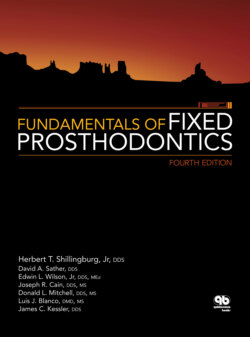Читать книгу Fundamentals of Fixed Prosthodontics - James C. Kessler - Страница 30
На сайте Литреса книга снята с продажи.
Centric Relation
ОглавлениеIn restorative treatment, the goal is to create occlusal contacts in posterior teeth that stabilize the mandibular position instead of creating deflective contacts that may destabilize it. In restorative treatment, the occlusion should be in harmony with the optimum condylar position, centric relation, which is an anteriorly, superiorly braced position along the articular eminence of the glenoid fossa, with the articular disc interposed between the condyle and eminence.1 This position is the most orthopedically stable position, and because it is a result of activated elevator muscles, it is also the most musculoskeletally stable position.2
This position of the condyles in the glenoid fossae has been discussed and debated for years. It is used in dentistry as a repeatable reference position for mounting casts in an articulator.3,4 The term attempts to define the optimum relative position between all of the anatomical components. Ideally, that condylar position is also coincident with maximal intercuspation of the teeth.4,5
For the concept of centric relation to be meaningful, the basic anatomy of the temporomandibular joint (TMJ) must be understood (Fig 2-1). The bone of the glenoid fossa is thin at its most superior aspect and is not suited to be a stress-bearing area. However, the slope of the eminence in the anterior aspect of the fossa is composed of thick cortical bone that is capable of bearing stress.
The articular disc is biconcave, devoid of nerves and blood vessels in the central area, and tough—much like a piece of shoe leather. It has a few muscle fibers attached in the anterior aspect from the superior lateral pterygoid muscle. The disc is attached to the condyle on its medial and lateral aspects and should be interposed between the condyle and articular eminence during function. The condyle is not spherical but has an irregular, elliptical shape. This shape helps to distribute stress throughout the TMJ rather than concentrating it in a small area.
Many methods have been used to guide the mandible into an optimal position. Earlier concepts of centric relation involved the most posterior condylar position in the fossa. The condyle was sometimes forcefully manipulated into the rearmost, uppermost, and midmost (RUM) position within the glenoid fossa,4,6–8 using chin point guidance. However, when the condyle is retruded, it might not be seated on the central area of the articular disc; instead, it might be on the highly vascular and innervated retrodiscal tissues (the posterior attachment) posterior to the disc9 (Fig 2-2). This can occur if the inner horizontal portion of the temporomandibular ligament has been unduly traumatized so that it no longer supports the condyle in a more anterior, physiologic position. It is presently thought that rather than being a physiologic position, this is frequently an abnormal, forced position that could create unnecessary strain in the TMJ. In this circumstance, the disc is displaced anteriorly, and clicking of the joint is frequently observed as the patient opens and closes.
The more recent concept describes a physiologic position in terms of the musculoskeletal relationships of the structures10 (Fig 2-3). It is not a forced position; rather, the mandible is gently guided by the operator using the bilateral method11 or by allowing natural muscle action to place the condyle in a physiologically unstrained position.12
Fig 2-1 Some of the components of the TMJ. A, articular eminence; C, condyle; D, articular disc; E, external auditory meatus; L, superior and inferior lateral pterygoid muscles; R, retrodiscal tissue (posterior attachment); S, thin superior wall of the glenoid fossa.
Fig 2-2 (a) In a dysfunctional joint with an internal derangement, the disc is displaced anterior to the condyle at the intercuspal position. (b) After initial rotational opening, the condyle is still posterior to the disc. (c) In translation of the mandible to maximum opening, the condyle recaptures the disc, clicking into position as it does.
Fig 2-3 (a) In a healthy joint, the condyle is in a superoanterior position in the fossa with the articular disc interposed when the teeth are in maximal intercuspation. (b) In the initial stage of opening, the condyle rotates in position, with the disc remaining stationary. (c) In maximum opening, the condyle translates forward, with the disc still interposed.
Fig 2-4 The mandible moves on a horizontal axis, as seen in a hinge axis opening.
Fig 2-5 Mandibular movement occurs around a vertical axis during a lateral excursion.
Fig 2-6 The mandible also rotates around a sagittal axis when one side drops down during a lateral excursion.
